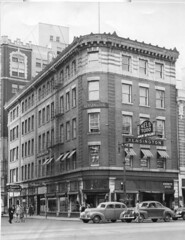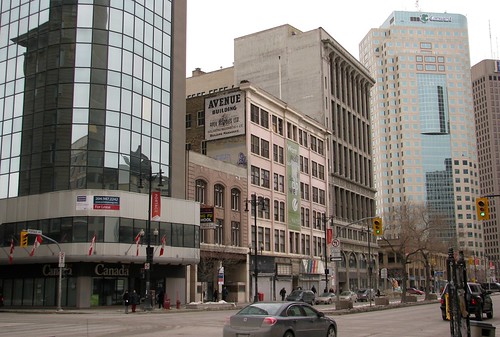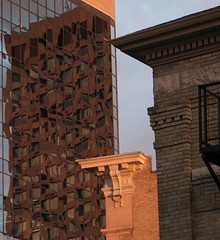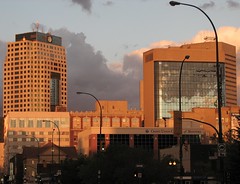Address: 275 Portage Avenue at Smith Street (Map)
Architects: Jack Ross (1974 version)
Size: 17 storeys, 91,000 square feet
Since 1905 this corner has been the home of two Kensington Buildings and has had just two property owners.
Kensington Block ca. 1940s (source)
The original building was constructed in 1905 on the site of Lowman's meat shop and a fruit stand for L. A. Oldfield. Oldfield owned at least two other properties but was not the real estate broker from Oldfield, Kirby (that was John Henry).
Oldfield was not the only one cashing in on the coming Eaton's building and Portage Avenue's new-found role as Winnipeg's premiere retail street. A Free Press article that year noted that "...there have been a number of small blocks erected, nearly all with apartments over them, and some of these are as far west as Sherbrooke Street, where hardware and drugstores have been established". (Free Press October 30, 1905)
The building may have been one or two stories shorter when it started out. It was clad in Twin City pressed brick with cut stone detail. The Portage Avenue frontage was 44 feet and it extended 150 feet to the north.
A notable main floor tenant was Emma & Panara and their Olympia Café. Decades later, the pair of Italian immigrants would open the Olympia, (now Marlborough), Hotel directly to the north. The second level was office space - ranging from a photography studio to a myriad of medical practitioners. The top storey contained 'splendid' bachelor suites for rent.
The Kensington Block opened in late 1905 with most of the tenants arriving in early 1906.
Winnipeg Free Press, June 6, 1933
In the summer of 1933 a new main floor tenant arrived: Broadway Florists. The company was founded in 1923 by Ernest Cholakis in a small storefront in The Curry Building. The move to the Kensington greatly increased their show space and gave them a mezzanine and basement storage as well.
Cholakis and sons (Source: Broadway Florists)
L. A. Oldfield died in 1929 and Cholakis purchased the building from the estate in June 1946 for $185,000. (Oldfield also owned The Honey Dew Building at Portage and Donald, now part of Mountain Equipment Co-op).
By the 1940s Cholakis' sons were part of the family business. Ernest Cholakis died in 1971.
By the 1940s Cholakis' sons were part of the family business. Ernest Cholakis died in 1971.
On December 10, 1972 fire struck the Kensington Block.
The fourth floor was destroyed, along with the law office of son Leo Cholakis and Alitalia Airlines. The rest of the building sustained heavy smoke and water damage. Firms on the main floor were Broadway Florists; London Shoe Renew; Harold Lyons Furs; The Needleworks; 'Mr. 8 Track', operated by wrestling promoter AI Tonko; and the Olympic Barber Shop. The upper floors included Finkleman Optometrists, who would relocate to the Avenue Building; Acme Furs; Gairdner Stock Brokers and Fraser's Construction.
In June 1973 Leo Cholakis applied for a high rise permit for a new building on the site.
Under construction, August 1974 (source)
The 17 storey structure required a unique and somewhat controversial feature - a sidewalk overhang. Cholakis and architect Jack Ross said that the encroachment was needed to allow for enough rentable floor space to make the building feasible. The alternative was to build something similar in size to what burned. The city approved an encroachment of 6.5 feet on Smith Street and 11 feet along Portage Avenue.
March 1975 (source)
In November 1973 the design was released. The $5 million Kensington Building would be 17 storeys, 227 feet, in height. The striking design feature was the 45,000 square foot glass wall that would wrap the building on two sides. Created by a thin layer of aluminum sandwiched between two inch thick pieces of glass, Cholakis said that "the appearance will be elegant". (Winnipeg Free Press, Nov 17, 1973). In true Winnipeg fashion, though, some motorists complained of the glare !
Winnipeg Free Press, April 28, 1976
In March 1975 the first tenants arrived: Indian and Northern Affairs Canada's regional office, (the federal government had a large presence in the building until 2004). A couple of businesses returned to their roots. Broadway Florists and investment house Walwyn, Stodgell & Gairdner Ltd. were tenants of the old Kensington building.
Kensington Building's45,000 sq. ft. glass wall
Kensington in the skyline
In the late 1970s a bank study examined downtown Winnipeg property tax rates and found incredible disparities between the north and south side of the street. Some north-side buildings were paying ten times the amount of property taxes and the Kensington Building had the dubious honour of having the highest property tax bill in the entire inner city. (Winnipeg Free Press, October 14, 1978).
Cholakis purchased the nearby Avenue Building and in the early 00s announced that he wanted to construct a $15m, 16 storey addition to the Kensington Building. There was difficulty obtaining the Hample Building which sat between the two so the Avenue Building was sold off.
In 2009 the Assembly of Manitoba Chiefs became a major tenant in the building.
Related:
The Kensington Building - U of M Winnipeg Building Index











Great post! Even though the Kensington Building is not really a crowd pleaser (probably due to the big blank wall on the east side), it is one of my personal favourites.
ReplyDeleteThis is a very unusual building for Winnipeg in that it is located on a sliver of land which it makes the most of. Buildings like this are a much more common sight in places with very high land values. I also like how it looks with the glass curtain wall that faces west.
From what I understand, the configuration of the building has made it tricky to lease, meaning that the vacancy rate has been a bit higher in there than in comparable downtown buildings (which is probably why the landlord badly wanted to expand it).
One of the more regrettable aspects of the building is that it hasn't really been able to attract a marquee tenant for the high-profile ground floor space. Ever since First City Trust moved out, it went from being empty to being a home for governmental/quasi-governmental offices like Canada Place and AMC. The whole block is pretty government heavy, for that matter.
I think me Kensington Block for your title.
ReplyDeleteOtherwise, great post!
Plus, I think you wanted "honour" instead of homour.
ReplyDeleteLol, thanks ! these things usually get posted at about 2 am so by that time my proofreading skills are pretty much shot !
ReplyDeleteNice pic of the Moore's taxi in front of the Kensington building. Unicity absorbed Yellow, Grosvenor and Moore's taxi in 1971-2, but as this photo shows the individual logos were still in use as late as 1975, presumably to capitalize on customer loyalty until the Unicity brand could be established. Unicity's fleet colour at the time was pale yellow bodies with black tops. The Moore's logo was a dark orange or bronze colour. Distinctive fleet colours were banned by the Manitoba Taxicab Board from 1935 to 1951 which may explain why they never really caught on here. Red Patch was the only other firm using them in the 1970s as I recall. The car is a '75 Plymouth Gran Fury. Furies were in vogue as police cars and taxis at the time.
ReplyDeleteI remember the encroachment controversy. I think the main concern was not so much with the design itself but with the possibility of creating a precedent for less elegant encroachments. I always liked the look of the K building and I certainly appreciate overhangs of any kind when it's raining.